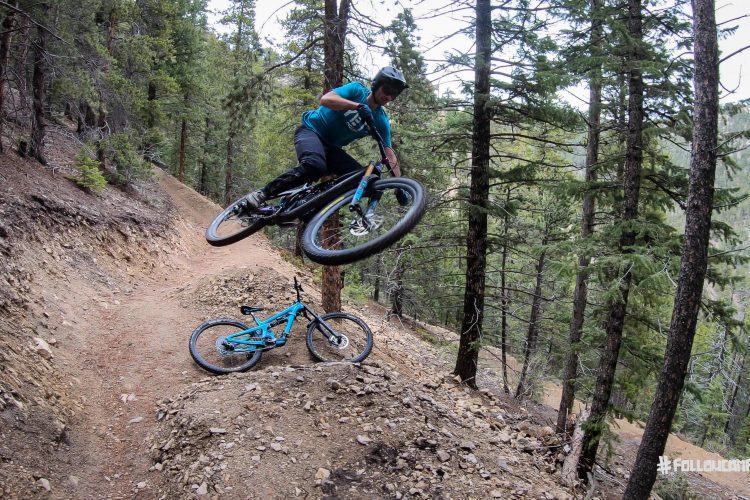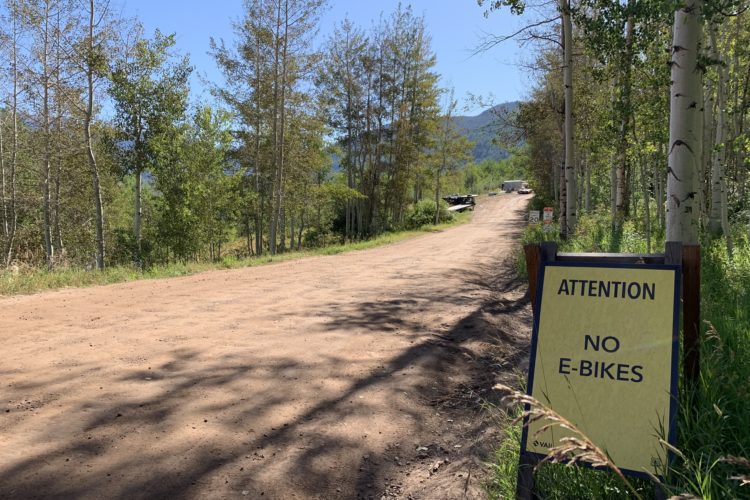
The entrance to Ore Chute, the latest double black diamond rated trail at Black Hawk, Colorado’s Maryland Mountain trail system is decisive. There is one entrance with two filter features. To the right: a tight turn into a steep and narrow stack of rocks with another tight turn at the bottom. To the left: a short series of 18-24″ ledges between a pinch of boulders with… a tight turn at the bottom. Passing the first of the two features is barely a litmus test for the remaining singletrack.
“It’s a confidence and commitment trail,” said Gary Moore, the executive director of the Colorado Mountain Bike Association. Ore Chute, at six-tenths of a mile long, drops almost a thousand vertical feet for an average grade of 27.7%. Riders spend their run down the trail following their front wheel over steep, dusty slopes and walls of rock with handfuls of brake at the ready. It’s not for everyone. In fact, it’s not for most. But a strong segment of Colorado mountain bikers have eagerly waited for a trail like this after sharing crowded multi-use trails with hikers for years and seeing a steady unrolling of machine-built flow trails.
Love at first sight

The master plan for Maryland Mountain was already underway when Moore visited the first time to meet with Black Diamond Trail Designs in the summer of 2020. The plan called for 10-12 miles of multi-use, bi-directional trail, made mostly for beginner and intermediate riders. COMBA wasn’t an official partner for the project yet, but Moore wanted to check out the mountain and see if he could help.
Joseph Litaker, the lead designer at Black Diamond, told Moore about a rock slab on the mountain he found during a survey and wanted to incorporate into the master plan. As it sat, the granite wall would have been a bonus feature on a multi-use intermediate trail. Moore wanted to work the feature into the plan too but it wasn’t right for an intermediate trail. Really, the feature and the surrounding terrain called for something outside the lines.
“It jumped out at me right away,” said Moore. “This needs to be a bike-only downhill and suited to the terrain, not forced into the master plan.” And it would come after the intermediate trail foundation of the Maryland system had been built.

As Moore wrapped up his survey with Litaker on the warm July day, they ran into exactly the people they needed to speak to: Black Hawk’s mayor, city manager, and fire chief. He didn’t waste any time and pitched the idea to the three. The area and potential trail “needs to be looked at as its own project and as the feather in the cap for this overall system,” he told them. Moore asked the mayor, does Black Hawk want the trail system to be a local recreation amenity or an enviable attraction? They chose the latter. COMBA sought to show Black Hawk the value in advocacy groups and how, with their passionate volunteer base, they could help shape the vision for Maryland Mountain, and create a magnetizing trail system.
The City of Black Hawk, built on mining in the 1800s and 1900s, had worked for 20 years trying to resolve mining claims and work through Bureau of Land Management red tape before they could purchase the 600-acre Maryland Mountain property in 2020 to establish a recreation area. When mining fizzled out, Black Hawk successfully transitioned to a mining-adjacent economy: gambling. But, as Black Hawk looked to the future and expanded tourism, mountain biking became a tangible next step.
“As the Front Range population and popularity of outdoor recreation activities continue to increase, Maryland Mountain Park is likely to receive even more visitors,” reads the master plan.
Finding the fun way down

The pillars of the trail system were built by the end of 2020, but the trails weren’t rideable until the summer of 2021. Hard Money, the system’s flagship trail — one with speed, jumps, and technical sections — opened along with Easy Money, Claim Jumper, and others. Maryland Mountain’s newly built Hidden Treasure Trailhead quickly filled up as riders from all over the Colorado Front Range poured in to ride the variety of trails.
COMBA continued working on more trails and decided it was time to approach the City about the double black diamond trail. Still on board and ready to see what COMBA and the Boulder Mountainbike Alliance (BMA) — another group that became involved — could cook up, Moore said they were in a peculiar spot. The City “really just turned us loose. It was an extremely unusual situation here in the Front Range.”
COMBA fundraised money from its members and bike brand Orbea, which had recently opened a U.S. headquarters 45-minutes from Black Hawk. COMBA contacted Jagged Axe Trail Designs who had experience and a reputation for building gnarly singletrack like the Glorieta Trails outside of Santa Fe and Shepherd Mountain in Missouri.
While the majority of COMBA’s trail builds of late have been assisted by mini-excavators, Ore Chute was to be built by hand, linking one natural feature to the next.
As they dug their way down, COMBA brought staff from the City to check out their work and mitigate any concerns. Advanced level mountain bikers joined them and rode down the slabs and chutes to demonstrate the type of riding that would happen. A little crazy? Sure. But rideable? Absolutely.

“The looks on their faces after somebody would ride some of that stuff were priceless,” said Moore. “They would turn around and go ‘Well, okay. It’s not going to be me but good on you.'”
COMBA continuously brought firefighters from the City on site to show them egress routes that had been built, signage to emphasize the risk to riders, a bailout halfway through the trail, and ropes in a short section of exposure. They assured staff it would also be a small segment of experienced riders who rode the trail, focused and cautious, and going much more slowly than they would on parallel trails like Hard Money.
“It’s visually intimidating more than it is really all that dangerous,” Moore said. The concerns were mainly riders who took a bad line or grabbed too much brake and went over the bars, rather than high-speed crashes on jump trails.
While a lot of new trails are built on the principle of sustainability and mitigating maintenance needs, Ore Chute will wear much differently than an excavated trail with grade reversals and drains, and it will take time to identify areas of improvement. That’s OK though, insists Moore. Not every trail needs to follow the same book.
“[Ore Chute is] just a way of getting from A to B in a way that’s fun.”
Lighting a fire

Two months after construction started on Ore Chute, it opened in mid-September as the temperatures cooled and leaves drifted off branches. Word quickly spread that the one-of-a-kind trail was ready to ride. Mountain bike access in the Front Range of Colorado just on the outskirts of the state’s biggest cities has been tough to grow for a number of reasons. As Moore mentioned, the Ore Chute trail is a feather in the cap for the City of Black Hawk and the Maryland Mountain trail system, but also for COMBA and BMA.
When it comes to the majority of the new trails COMBA has advocated for and helped build, it’s usually the top 10% of riders who aren’t thrilled, Moore said.
“Most of the blowback we get to our trails projects come from these riders that are at the upper end of the scale because it’s not the experience and it’s not the challenge that they’re looking for.” Now that Ore Chute is open, it’s evident to more of the advanced mountain bike community that COMBA is looking out for everyone’s interests, even if it’s not possible all the time.
“Ore Chute is only six-tenths of a mile long and it’s something that energizes a part of our community that generally isn’t super engaged with our efforts,” he said.
Though out-of-state builders designed the trail, COMBA and BMA involved local volunteers as part of the build, like any project. They’d be the ones riding it for years to come and the organizations wanted them to feel invested in the work. Since Ore Chute opened, Moore said he’s connected with more advanced riders than ever, who have contributed financially or through volunteer hours. As an organization that advocates for the interests of all riders in its region, Moore hopes that opening the trail may make his job easier when he’s pitching new ideas to people in charge of the land.
“The fact that Ore Chute now exists opens up some more headroom in what is considered possible on public lands and I hope that gives us the opportunity to convince some other land managers to build stuff along that nature.”





















5 Comments
Dec 27, 2022
I love this paragraph:
"While a lot of new trails are built on the principle of sustainability and mitigating maintenance needs, Ore Chute will wear much differently than an excavated trail with grade reversals and drains, and it will take time to identify areas of improvement. That’s OK though, insists Moore. Not every trail needs to follow the same book."
And I hope this rings true as well:
“The fact that Ore Chute now exists opens up some more headroom in what is considered possible on public lands and I hope that gives us the opportunity to convince some other land managers to build stuff along that nature.”
There are other examples of such on public (not rouge) trails and I hope they keep coming!
Way to go Blackhawk!!!
Dec 29, 2022
That said, I am very happy they built something like this in the area. I hope it lives up to its halo status and with the rest of the Maryland Mountain trail system brings some interested riders in with a measurable economic impact so that Colorado starts putting more emphasis on mountain biking.
Dec 29, 2022
Dec 30, 2022
Jan 3, 2023